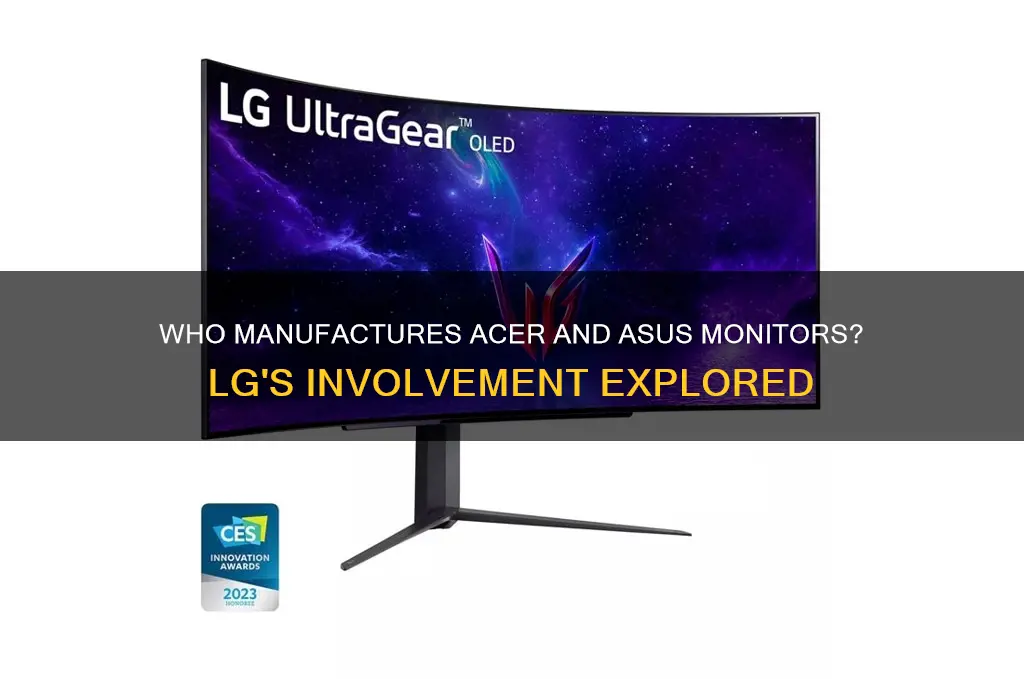
LG, Acer, and Asus are all well-known monitor brands, but do LG manufacture Acer and Asus monitors? The answer is no. LG, Samsung, AU Optronics, Innolux, BOE, and Sharp are some of the biggest monitor panel manufacturers, and both Acer and Asus use panels from these companies. Acer and Asus then add their own electronics and backlighting to create their monitors.
What You'll Learn

Acer manufactures monitors in Taiwan and China
Acer's gaming monitors are particularly popular, with their Nitro and Predator lineups providing versatile options for gamers and professionals alike. The Nitro lineup offers a range of specifications, including different panel types, resolutions, and refresh rates, while the premium Predator lineup is known for its high-performance features.
In addition to their gaming-focused models, Acer also produces basic monitors designed for simple office work. These monitors typically have fewer features but are suitable for everyday computing tasks.
Acer's manufacturing capabilities and diverse product offerings make it a prominent player in the global monitor market, with a strong presence in both Taiwan and China.
Monitoring Plex CPU Usage: A Comprehensive Guide
You may want to see also

LG manufactures its own OLED panels
LG is an international electronics company headquartered in South Korea. They offer a wide range of monitors, with new models coming out each year. One advantage LG has is that they produce their own OLED panels, so they've started making OLED monitors, like the LG 32GS95UE-B, which is one of the best LG monitors. It's a unique monitor with a 4K resolution and 240Hz refresh rate that you can switch into a 1080p, 480Hz Dual-Mode. These OLEDs are good if you want the best picture quality as they display deep blacks in dark rooms, but if you're concerned about the risk of burn-in that OLEDs face, they have some great LED monitors available.
LG Display, based in Korea, is one of the world's largest display makers. LG Display is the world's leading OLED TV and monitor panel producer (based on its WOLED architecture). The company also produces flexible AMOLEDs for wearables, tablets and smartphones (branded as pOLEDs, and supplied to many companies including Apple). LG Display is also offering automotive OLED displays, transparent OLEDs, and is developing OLED microdisplays.
LG Display supplies WOLED TV panels in a wide range of sizes, from 42-inch to 97-inch, to many companies including Panasonic, LG Electronics, Sony, Philips, Loewe, JVC, Hisense, Konka and others. It is a main AMOLED supplier for Apple's smartwatch, mobile phones and tablet products. It is also considered to be the leading automotive OLED producer.
LG Display has been producing transparent OLEDs since 2019, when the company started commercial production of 55" FHD transparent OLEDs, finding small markets in signage, commercial, mobility and more. The company since expanded its range, although production volume is still limited.
LG Display will reportedly supply more than 10 million OLED panels to Samsung over the next few years. LG has more than 50 percent market share of lucrative OLED TVs, with Sony at 26 percent and Samsung at just 6 percent, according to market research from Omdia.
Verizon's Home Internet Monitoring: What You Need to Know
You may want to see also

ASUS is a Taiwanese company that manufactures the Republic of Gamers (ROG) and TUF Gaming monitors
ASUS, also known as ASUSTeK, is a Taiwanese multinational computer hardware manufacturer. They have diverse lineups for different needs, and their popular gaming lineups include the Republic of Gamers (ROG) and TUF Gaming monitors.
ASUS was founded in Taipei, Taiwan, in 1989 by four hardware engineers who had previously worked at Acer. ASUS is currently the world's fifth-largest personal computer vendor by unit sales. The company's name originates from Pegasus, the winged horse of Greek mythology, with only the last four letters used to ensure a high position in alphabetical listings.
The Republic of Gamers (ROG) is a brand used by ASUS since 2006, encompassing a range of computer hardware, personal computers, peripherals, and accessories. The Ultimate Force (TUF) is another brand used by ASUS since about 2010 for its affordable, mid-range gaming products.
ASUS offers a wide range of monitors, including the following from the ROG series:
- ROG Swift OLED PG32UCDM: 32-inch 4K QD-OLED panel, 240Hz, 0.03ms response time, G-SYNC compatible, custom heatsink, uniform brightness, 99% DCI-P3, and 90W Type-C.
- ROG Swift OLED PG27AQDM: 27-inch 1440p OLED panel, 240Hz, 0.03ms response time, G-SYNC compatible, anti-glare, custom heatsink, uniform brightness, and DisplayWidget Center.
- ROG Strix XG27ACS: 27-inch 2560x1440 resolution, 180Hz, 1ms response time, Fast IPS, Extreme Low Motion Blur Sync, USB Type-C, G-Sync compatible, DisplayWidget Center, and tripod socket.
- ROG Swift Pro PG248QP: 24.1-inch FHD resolution, 540Hz, Esports-TN panel, NVIDIA Reflex Analyzer, ULMB 2, adjustable base, ESS codec, and DisplayHDR 400.
Monitoring Hulu Data Usage: Tips to Keep Your Data in Check
You may want to see also

Dell manufactures monitors in the US and China
In addition to manufacturing monitors in China, Dell has decided to stop sourcing the chips used in its products from China before the end of 2024. Dell is also expected to move 50% of its production outside of China by 2025. This likely means that Dell would continue to manufacture PCs for China within China but move to other locations for manufacturing products sold elsewhere in the world.
App Usage Monitor: What's the Deal?
You may want to see also

Samsung manufactures monitors in South Korea
Samsung is a South Korean multinational manufacturing conglomerate. It is headquartered in Yeongtong-gu, Suwon, South Korea, and is the largest South Korean chaebol (business conglomerate). Samsung Electronics, the flagship company of the Samsung Group, manufactures monitors, among other products.
Samsung Electronics has assembly plants and sales networks in 76 countries and employs more than 260,000 people. The company's South Korean facilities form a triad (Giheung, Hwaseong, and Pyeongtaek) of knowledge-sharing and fast transport. These three world-class facilities, located within an 18-mile radius, collaborate to supercharge development and streamline customer services. Samsung's South Korean manufacturing network includes:
- The Giheung fab, founded in 1983, which specializes in mainstream nodes ranging from 350nm to 8nm solutions.
- The Hwaseong fab, established in 2000, which employs the latest R&D and production capabilities, including breakthrough EUV. Hwaseong produces the 10nm to 3nm processes that power leading-edge products.
- The state-of-the-art Pyeongtaek fab, which mass-produces further advanced nodes as Samsung seeks new frontiers and pushes the boundaries of Moore's law.
Samsung Foundry's footprint also spans the U.S., with the Austin and Taylor fabs in Texas designed to increase capacity and flexibility for a growing network of manufacturing customers. The Austin fab, the largest single fab in the U.S., has been in operation since 1996 and provides stable manufacturing of 65nm to 14nm processes. The new 5 million ㎡ fab in Taylor, supported by the nearby Austin site and collaboration with Korea's manufacturing network, ensures the rapid scaling of Samsung Foundry's global manufacturing capabilities.
Monitoring Employee Internet Usage: Company Surveillance Exposed
You may want to see also







